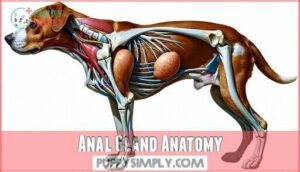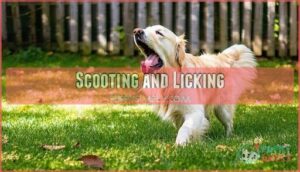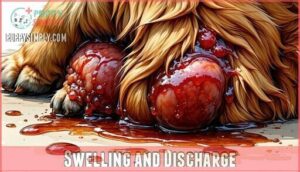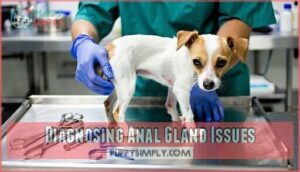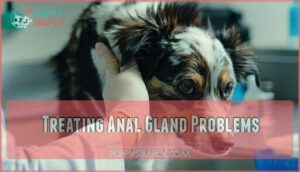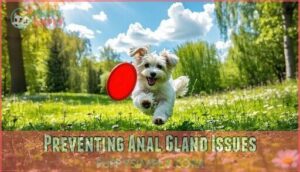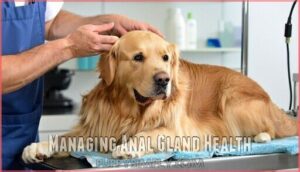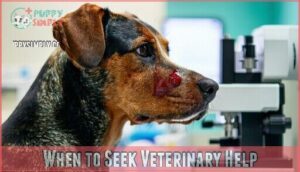This site is supported by our readers. We may earn a commission, at no cost to you, if you purchase through links.
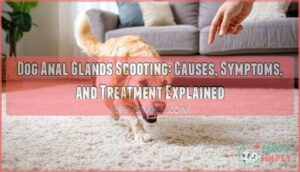 If your dog is scooting across the floor like they’re training for a canine drag race, it might be due to anal gland issues.
If your dog is scooting across the floor like they’re training for a canine drag race, it might be due to anal gland issues.
These tiny sacs near their rear end can get blocked or infected, causing itchiness, discomfort, and that unmistakable booty shuffle.
Other signs include licking, swelling, or even a bad smell.
Certain breeds, low-fiber diets, or allergies can make things worse.
While you can try increasing fiber or ensuring regular gland expression, persistent scooting calls for a vet visit.
Don’t ignore it—left untreated, it can lead to infections.
Curious about preventing these stinkers? There’s more to explore!
Table Of Contents
- Key Takeaways
- What Are Anal Glands
- Causes of Anal Gland Issues
- Symptoms of Anal Gland Problems
- Diagnosing Anal Gland Issues
- Treating Anal Gland Problems
- Preventing Anal Gland Issues
- Managing Anal Gland Health
- When to Seek Veterinary Help
- Frequently Asked Questions (FAQs)
- Why does my dog Scoot after expressing anal glands?
- How do I know if my dog’s anal glands are full?
- Why does my dog have a clogged anal gland?
- Why does my dog Scoot a lot after having glands expressed?
- What if my dog has impacted anal glands?
- What are anal glands in dogs?
- What is the cure for scooting in a dog?
- Does scooting always mean worms?
- What is the difference between anal glands and anal sacs?
- Are there any home remedies for anal gland issues?
- Conclusion
Key Takeaways
- Keep an eye out for signs like scooting, licking, or a fishy smell—it often means your dog’s anal glands are full or irritated.
- A fiber-rich diet, regular exercise, and proper grooming can help prevent anal gland issues.
- If scooting persists or you see swelling, discharge, or discomfort, visit your vet to avoid infections or complications.
- Home remedies like warm compresses and adding canned pumpkin to meals can provide relief, but don’t skip a vet check for persistent problems.
What Are Anal Glands
Anal glands are small sacs located on either side of your dog’s anus, producing a strong-smelling fluid used for scent marking.
These glands play a natural role in communication among dogs but can cause issues if they become full or irritated, which is related to their function in scent marking.
Anal Gland Anatomy
Dog anal glands are small, oval sacs located inside the rectum, sitting at four and eight o’clock near the anus.
These glands rely on nerve supply to release secretions, holding a unique scent composition that’s specific to each dog.
This glandular structure varies between dogs, showcasing individual variation.
Understanding canine anal glands helps spot potential issues early, ensuring your pet stays healthy with a proper functioning of their anal glands.
Function and Purpose
You’ve learned about their anatomy, but what exactly do anal glands do? These tiny glands play a big role in scent communication, acting like a calling card for dogs.
Through gland secretions, they mark territory with a unique fluid composition.
- Individual odor helps other dogs identify them.
- Scent communication prevents conflicts.
- Territorial marking occurs during defecation or scooting behavior.
Causes of Anal Gland Issues
Anal gland issues in dogs can stem from factors like impaction, infections, or even their diet.
Small breeds, allergies, and soft stools often make the problem worse, leaving your pup uncomfortable.
Impaction and Infection
Sometimes, those tiny sacs under your dog’s tail face glandular obstruction, leading to anal gland impaction or even bacterial overgrowth.
Those tiny sacs can clog, causing anal gland impaction, bacterial overgrowth, swelling, and discomfort that your pup shouldn’t have to endure.
It’s like plumbing—when things clog, swelling and chronic inflammation can occur.
Left unchecked, abscess formation or an anal gland rupture might follow, requiring surgical intervention.
Regular check-ups help address issues early and prevent anal gland infection from spiraling into something worse.
Diet and Allergies
A poor diet can cause chaos for your dog’s anal glands.
Fiber deficiency and food sensitivities often lead to softer stools, making scooting behavior worse. Watch out for dog allergies—common triggers include grains and processed foods.
Help your pup with:
- Diet Elimination: Remove allergens gradually.
- Novel Proteins: Try bison or duck.
- Allergy Management: Balance nutrition for healthier glands.
Breed and Size Factors
Smaller dogs, like Chihuahuas and Dachshunds, often face anal gland trouble due to small gland size and weaker muscles.
Spaniel subgroups also show breed predisposition, while anatomical differences and obesity influence gland health.
A breed-specific diet can help manage risks, and unlike larger dog breeds, small dog breeds need extra care to avoid scooting episodes tied to these factors.
Symptoms of Anal Gland Problems
You’ll notice something’s wrong if your dog scoots across the floor, licks their rear nonstop, or seems uncomfortable sitting down.
Other signs, like swelling near the anus or a strong fishy smell, can point to anal gland issues that need attention.
Scooting and Licking
Your dog’s scooting behavior might look amusing, but it often signals perianal irritation or rectal itching.
Excessive licking causes further discomfort and could hint at infection risks tied to full or irritated dog anal glands.
Preventative grooming and monitoring are essential, and you can offer scooting relief methods like a balanced diet or vet advice, addressing behavioral components before they worsen.
Swelling and Discharge
If you notice anal bulges or swelling near the anus, it could mean your dog’s anal glands are impacted.
Look for discharge color—brown or bloody—and a fishy discharge odor that screams “vet visit.”
Swelling causes include infection signs, like perianal inflammation or anal sac abscess.
Scooting behavior often points to this, so check glands regularly to identify potential issues, including infection signs.
Pain and Discomfort
When anal glands are impacted, your pup might struggle with sitting discomfort or defecation pain.
Anal sensitivity often leads to scooting behavior, as they try to ease the irritation. You might see perianal inflammation or notice them avoiding sitting altogether.
Providing irritation relief, like warm compresses, can help. If swelling alleviation isn’t enough, consult a vet for persistent dog discomfort or anal gland issues.
Diagnosing Anal Gland Issues
When figuring out why your dog is scooting, a physical exam is the starting point.
Vets use palpation techniques to check for anal gland impaction, swelling, or tenderness.
They may gently press the glands to identify blockage or infection while checking for unusual discharge.
Odor analysis can give clues—if there’s a strong fishy smell, the glands might be full.
Imaging options, like ultrasounds, help if deeper issues are suspected.
Sometimes, scooting behavior links to other anal gland symptoms like redness or bumps, which vets examine closely.
Discharge examination can reveal infections needing treatment.
Diagnosing dog scooting causes isn’t just about visible signs; a vet’s keen eye guarantees nothing serious is overlooked—because a wagging tail deserves full comfort with proper anal gland care and vets who can identify infection.
Treating Anal Gland Problems
If your dog’s scooting is tied to anal gland problems, there are several effective treatment options.
From dietary changes to antibiotics or, in severe cases, surgery, you can help your pet find relief and get back to their tail-wagging self.
Expression and Antibiotics
If your pup’s scooting stems from anal gland impaction or infection, anal gland expression may provide relief.
It’s a hands-on job best left to your vet or groomer to avoid injury.
Antibiotics tackle infections, but watch for antibiotic resistance.
Limit expression frequency to every 4 weeks, and focus on post-expression care like soothing the area.
Dietary Changes and Supplements
When manual expression doesn’t cut it, dietary changes and supplements can help ease your dog’s scooting.
A fiber-rich diet firms up stool, naturally emptying glands. Probiotics improve gut health, while enzyme supplements manage allergies. Add omega-3s for inflammation relief.
A balanced diet may require a dog fiber supplement for ideal results.
Consider these ideas:
- Pumpkin as a fiber boost
- Raw meaty bones for stool consistency
- Probiotic benefits for digestion
- High-fiber treats
Surgery and Removal
If changes in diet and supplements don’t help, veterinary surgery might be the next step.
Anal gland removal, or sacculectomy, is a lasting solution for persistent issues like abscesses or tumors.
While surgical risks exist, post-op care is manageable with hygiene, medication, and rest, and recovery timelines usually span 2-3 weeks, but consult your vet about cost factors and sacculectomy alternatives.
Preventing Anal Gland Issues
You can prevent anal gland issues by keeping your dog’s diet balanced and high in fiber, which helps maintain firm stools for natural gland expression.
Regular exercise, proper hydration, and good grooming habits also go a long way in keeping your pup comfortable and healthy.
Diet and Fiber
A fiber-rich diet works wonders for dog anal glands, keeping stool consistent and promoting natural drainage.
Try these fiber sources:
- Add pumpkin or sweet potato to meals.
- Mix ground flaxseed into food.
- Opt for high-quality, fiber-filled dog kibble.
- Consider an allergy diet if sensitivities arise.
- Watch weight—a balanced diet guarantees proper stool consistency and overall dog nutrition.
Exercise and Hydration
Regular exercise improves mobility and prevents dog obesity, aiding natural anal gland drainage.
Hydration keeps stools firm yet manageable.
Consistent walks or playtime reduce inactivity-related scooting and bolster joint health.
The benefits of regular exercise and proper care for dogs are numerous, including improved mobility, healthy stools, and joint support.
| Benefit | Cause | Solution |
|---|---|---|
| Improved Mobility | Lack of Activity | Walks, agility exercises |
| Healthy Stools | Low Water Intake | Increase fresh water access daily |
| Joint Support | Age-Related Mobility Issues | Mild post-exercise care like stretches |
Regular Grooming
Keeping your dog’s rear end tidy makes a big difference for overall hygiene.
Sanitary clipping prevents matting and helps you spot issues early.
Grooming frequency depends on breed specifics—long-haired dogs need extra care.
Professional groomers can handle this if you’re unsure.
Regular grooming isn’t just about looks; it reduces scooting and keeps your pet comfortable.
Proper tools are essential, so consider investing in quality grooming products.
Clean fur, happy pup!
Managing Anal Gland Health
You can keep your dog’s anal glands healthy by monitoring their behavior and ensuring a balanced diet with enough fiber.
Regular care, like grooming and occasional check-ups with your vet, helps prevent discomfort and keeps them feeling their best.
Monitoring and Maintenance
Watching for changes can keep your dog’s anal glands healthy.
Simple habits support comfort and prevent scooting:
- Check regularly for redness or swelling.
- Stick to dietary consistency for firmer stools.
- Maintain hydration levels to avoid complications.
- Incorporate exercise routines for natural expression.
- Prioritize grooming practices to support hygiene.
Spotting issues early saves your pup from discomfort—and you from lingering odors!
Home Remedies and Care
A warm compress can work wonders for dog scooting home care—soak a cloth in warm water and apply it gently.
Pair this with fiber supplementation, probiotic support, and dog scooting dietary supplements for healthier stools.
Many pet owners find supplementing their dog’s diet beneficial for anal gland health.
Sanitary clipping and regular grooming practices improve hygiene, while dog scooting natural remedies like chamomile compresses soothe irritation, keeping your pup’s rear end happy.
Veterinary Check-ups
Veterinary check-ups are your dog’s safety net, catching anal gland problems before they spiral out of control.
During an annual exam, vets focus on:
- Preventative care to manage risks.
- Early detection of recurring health issues.
- Ensuring vaccine schedules stay on track.
- Offering dog scooting treatment options.
- Recommending professional grooming for hygiene.
A vet visit can save you worry—and your pup discomfort!
When to Seek Veterinary Help
If your dog’s scooting is frequent, paired with pain, or shows severe symptoms like swelling or bleeding, it’s time to contact your vet.
Ignoring these signs could lead to infections or complications that are much harder to treat, and this could result in more severe issues, making it essential to address the problem promptly to prevent further complications.
Severe Symptoms and Pain
If your dog refuses to sit, shows severe scooting, or whimpers with intense pain signs, it might point to an abscess rupture or systemic illness.
Severe scooting paired with whimpering or refusal to sit could signal an abscess rupture—urgent veterinary care is essential.
Severe bleeding near the anal area often signals serious anal gland problems.
Ignoring these symptoms risks worsening the condition. When pain becomes crippling, it’s time to seek urgent help from your vet without hesitation.
Recurring Issues and Infections
Recurring anal gland infections can be stubborn, leading to chronic inflammation and discomfort.
Antibiotic resistance might develop if treated improperly, so always follow your vet’s advice.
Infections or an anal sac abscess often require long-term management, like probiotics for gut health.
Left untreated, complications like surgery may arise, but careful monitoring and dietary adjustments can keep those infected glands under control.
Emergency Situations and Complications
If your pup shows signs like a ruptured abscess, bleeding, or worsening pain, it’s not time to wait.
Untreated infections can lead to septic shock, prolapsed glands, or even anal fistulas.
A dog anal gland rupture can quickly escalate to serious health problems.
Seek emergency care to avoid complications and restore comfort for your furry friend, as emergency care is crucial in such situations.
Frequently Asked Questions (FAQs)
Why does my dog Scoot after expressing anal glands?
Your dog might scoot after expressing anal glands due to lingering irritation or inflammation.
It could also be habit or discomfort.
A warm compress or gentle cleaning might help, but check with your vet if it persists.
How do I know if my dog’s anal glands are full?
If your dog’s booty seems busier than a squirrel in a nut factory—scooting, licking, or emitting a fishy odor—it’s likely their anal glands are full.
Swelling or discomfort near the anus seals the deal.
Why does my dog have a clogged anal gland?
A clogged anal gland happens when thick fluid builds up, often due to soft stools, a low-fiber diet, or allergies.
Small breeds, obesity, or poor grooming can increase the risk.
Regular check-ups help prevent issues.
Why does my dog Scoot a lot after having glands expressed?
Sometimes, after expression, irritation or lingering inflammation can cause scooting.
It’s like an itch that doesn’t quit!
Warm compresses and checking for lingering issues, like swelling or infection, can quickly soothe your dog’s rear-end woes.
What if my dog has impacted anal glands?
Imagine a balloon too full to pop—that’s an impacted anal gland.
Visit your vet quickly.
They’ll safely express it, possibly prescribe antibiotics, or suggest dietary tweaks.
Left untreated, it can swell, infect, or even abscess.
What are anal glands in dogs?
Anal glands are small sacs near a dog’s anus that produce a foul-smelling liquid used for scent marking.
They’re like your dog’s personal signature – stinky but essential for communicating with other pups!
What is the cure for scooting in a dog?
To stop your dog’s scooting, start with a vet check.
It might be full anal glands, allergies, or worms.
Adding fiber, regular exercise, and proper grooming can help keep those glands happy and healthy!
Does scooting always mean worms?
Scooting doesn’t always mean worms—it could signal anal gland issues, allergies, or skin irritation.
Check for other signs like a fishy odor or redness, and consult your vet to identify and treat the cause.
What is the difference between anal glands and anal sacs?
Anal glands are two small scent-producing glands inside a dog’s rectum, while anal sacs are the pouches that hold the gland’s fluid.
Think of sacs as storage containers and glands as the fluid factories!
Are there any home remedies for anal gland issues?
Imagine this scenario: your dog dragging its bottom across the floor.
Try warm compresses on their rear, add fiber like canned pumpkin to firm stools, and keep hygiene spot-on.
Still struggling? A vet visit’s your ace.
Conclusion
Wondering if your dog’s scooting could be serious? Don’t wait—it might be anal gland issues.
Addressing this early can save your pup from pain and discomfort. Keep their diet balanced, watch for scooting or licking, and maintain regular grooming.
If problems persist, a vet visit is essential to prevent infections or complications. Remember, managing dog anal glands scooting isn’t just about treatment—it’s about keeping your furry friend healthy and wagging happily for years to come.

